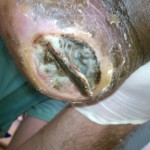For a number of years I have referred in my lectures to the word I have termed “Pseudomonaphobia”. Basically, this is an irrational fear of the organism Pseudomonas aeruginosa (PA) when isolated from a culture of a wound in the foot. I really believe that this arises in most Podiatrists during the residency interview process when, without fail they are asked by the interviewer “How would you treat a Pseudomonas infection in the foot?” I remember being prepped for that question way back in 1981 when we were instructed that the correct response was “You use a combination of gentamicin and carbenicillin”. Unfortunately, that was incorrect even back then since the more “current” schools were teaching their students to respond with a combination of tobramycin & ticarcillin, the so-called T&T therapy. (This may explain why I did not get my first choice of residency program!) Fortunately, today the well prepared student should be able to recite about a dozen different, non-aminoglycoside options. But, that is beside the point. It really is a moot issue. You see, despite the ability to readily culture the organism from lower extremity wounds, PA is RARELY a pathogen in lower extremity infections. In fact, I would go as far as saying that about the only time PA should be empirically considered pathogenic is in a case of osteomyelitis following a puncture wound.
A number of randomized, controlled clinical trials have actually substantiated this viewpoint. Most have looked at the clinical outcome of patients who grew PA from a wound/infection when treated empirically with an antibiotic that was ineffective against PA vs. one which had anti-pseudomonal activity. In this entry I will present 3 such trials.
In 2002 Graham, et.al. published the results of the pivotal phase III trials comparing ertapenem to piperacillin/tazobactam for complicated skin and skin structure infections (PubMed link: http://www.ncbi.nlm.nih.gov/pubmed/12015692). Of these two antibiotics ertapenem has no inherent anti-PA activity while pip/tazo does. Despite this difference in spectrum, the positive clinical response in patients growing PA was 70% for ertapenem and 60% for pip/tazo. In a very similar trial comparing the same two antibiotics specifically for diabetic foot infection, Lipsky et. al. had similar outcomes with a positive clinical response in 76.9% of patients on ertapenem vs. 70% for pip/tazo. (The SIDESTEP trial http://www.ncbi.nlm.nih.gov/pubmed/16291062). More recently, in September 2010, Corey, et. al. published the results of the clinical trials on the new anti-MRSA cephalosporin ceftaroline . This drug has no inherent anti-PA activity yet there was a positive clinical response in 80% of the patients from which the organism was isolated.
None of these trials are meant to show that the study drug had some previously undiscovered anti-PA activity. They just point to the role of PA as a notorious colonizer of lower extremity wounds/infections. Nannini stated it quite succinctly in his review paper of ceftaroline (http://www.ncbi.nlm.nih.gov/pubmed?term=nannini%20ceftaroline):
“The demonstration of efficacy in patients with P. aeruginosa receiving ceftaroline, a pathogen against which ceftaroline has little activity, most probably reflects the presumptive role of P. aeruginosa as a colonizer rather than a true pathogen in many of these infections.”
Please do not misinterpret me. I am not saying that PA is always a colonizer and is never pathogenic. If this bug is found from a reliable, deep surgical culture, consideration should be given to covering it. However, this is a ubiquitous organism that has been found in tap water and on plants and vegetables. Just culturing it from a superficial wound swab will lead the clinician to treat an organism that can most likely be handled with thorough debridement and topical therapy, with an anti-PA antibiotic that may be unnecessary. This may increase resistance of the organism against these antibiotics so that they are not available for the next time…when we may really need them.


